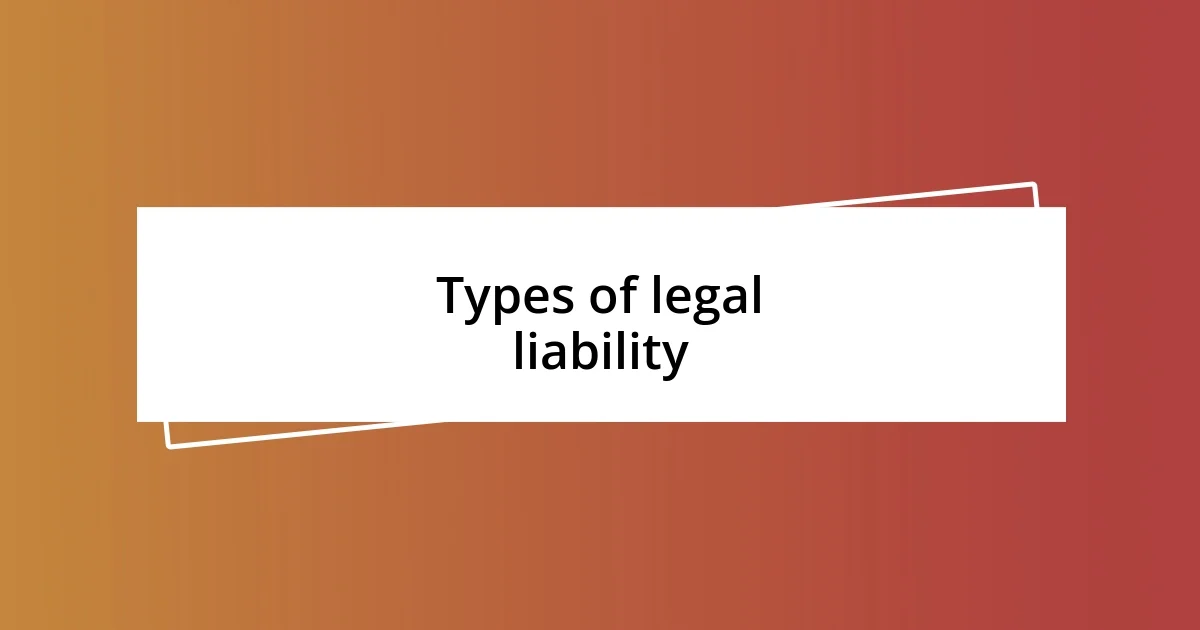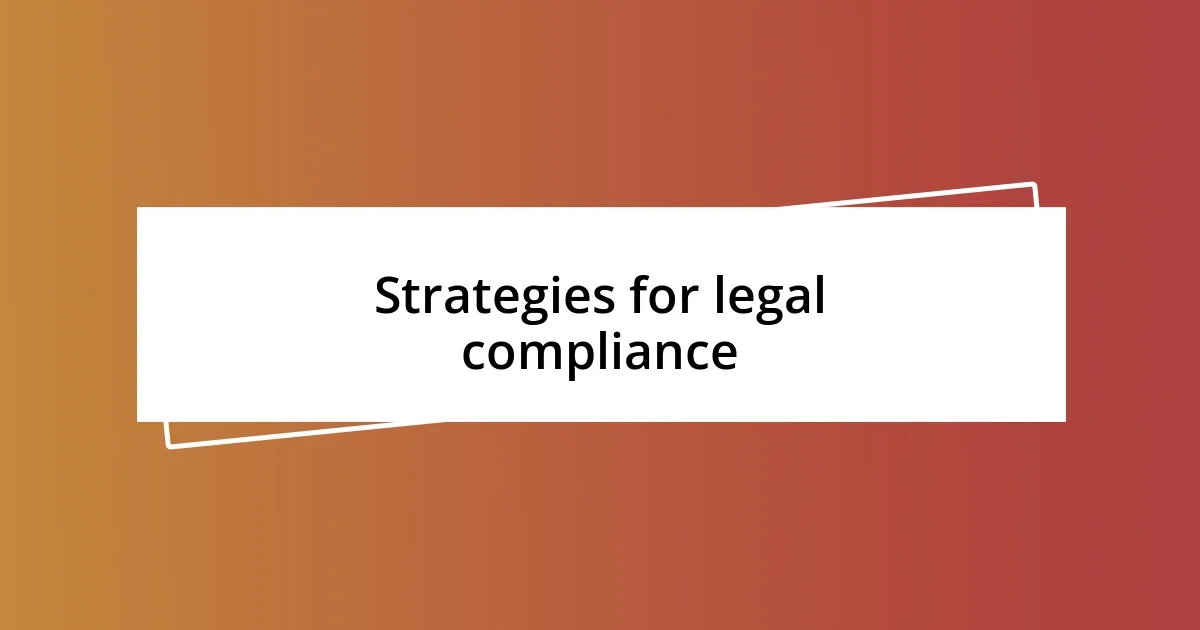Key takeaways:
- Legal liability encompasses responsibility for harm caused through intentional actions, negligence, or vicarious scenarios, highlighting the importance of awareness and accountability.
- Different types of liability—criminal, civil, and strict—each have unique implications that affect personal and professional landscapes, requiring a deep understanding of one’s actions.
- Mitigating legal risks involves proactive communication, compliance culture, and continuous training, along with thorough documentation and legal consultation during claims handling.

Understanding legal liability
Legal liability is essentially the responsibility one holds when their actions cause harm or damage to another person or entity. I remember the first time I encountered this concept during a college dispute resolution course. It hit me that understanding liability isn’t just about knowing the law; it’s about recognizing the impact our choices can have on others.
When we think about legal liability, a key aspect is the distinction between intentional actions and negligence. Have you ever accidentally caused an accident, perhaps while multitasking or simply overlooking an important detail? I’ve had moments like that, and it made me realize how easily we can find ourselves liable—and how crucial it is to be aware of our environment and responsibilities.
Moreover, liability can extend beyond personal actions to include vicarious liability, where one party is held accountable for the actions of another. This can be especially poignant in workplace scenarios. I once worked for an organization where a miscommunication led to a serious issue, leaving me to ponder: how far can responsibility stretch? This question really underscores the importance of fostering a culture of accountability, don’t you think? Understanding these layers of liability is vital for anyone navigating legal waters.

Types of legal liability
There are several types of legal liability that one should be aware of, as each can have significant implications in different contexts. I’ve come across these concepts through various experiences, and it’s fascinating how they intersect in everyday life. Broadly speaking, legal liability can be divided into three main categories:
-
Criminal liability: This arises when a person commits a crime, warranting punishment by the state. I recall a friend facing legal trouble for a poor decision made during a late-night outing. It served as a stark reminder that criminal actions can have long-lasting repercussions.
-
Civil liability: This typically involves disputes between individuals or entities where one party seeks compensation for harm caused by the other’s actions. I was once involved in a minor car accident that quickly escalated into a civil liability case. It was eye-opening to see how quickly the focus shifted from the accident itself to the legal processes that followed.
-
Strict liability: In these cases, a party can be held responsible for harm without establishing fault or negligence. Experiencing strict liability firsthand when a product I bought turned out to be defective left me feeling uneasy about consumer safety. It reinforced the idea that sometimes, accountability extends beyond intent.
Understanding these types of legal liability can help us navigate complex personal and professional landscapes. They remind us that our actions—or inactions—carry weight in ways we might not always foresee.

Factors influencing legal liability
Legal liability is influenced by various factors that can complicate the determination of responsibility. One major aspect is the standard of care expected in a given situation. For instance, I once attended a cooking class where the instructor emphasized kitchen safety. I realized that failing to follow safety protocols not only jeopardizes personal well-being but could also lead to liability if someone got hurt. This experience reinforced my understanding that the expectation of care can vary significantly depending on the context.
Another critical factor is the relationship between the parties involved. I think back to a personal encounter where I witnessed a neighbor’s dog causing an accident. The question arose: should the owner be liable since they weren’t directly involved? Here, the concept of liability had to do with the owner’s control over their pet. It made me reflect on how relationships often define responsibility in ways that may not be immediately obvious.
Lastly, the existence of insurance can shape liability outcomes. When I decided to take out an umbrella insurance policy, it reassured me that I was covered in case of unforeseen incidents. This protective cushion plays a key role in mitigating financial risks associated with legal liability. Understanding these factors can transform our perspective on responsibility and accountability.
| Factor | Description |
|---|---|
| Standard of Care | The expected level of caution based on the situation; varies by context. |
| Relationship | The ties between parties that influence who’s liable; can complicate liability assessments. |
| Insurance | The coverage that can mitigate financial risks linked to liability issues. |

Assessing legal risk effectively
Evaluating legal risk starts with a thorough understanding of the specific context you’re in. I remember working on a project where we had to navigate regulatory requirements, and it was daunting. Each guideline felt like a potential landmine, but taking the time to dissect the regulations helped us identify the risks before they could escalate. Have you ever felt overwhelmed by the legal jargon around you? It’s vital to break it down into manageable bits.
I’ve found that conducting regular risk assessments can reveal hidden vulnerabilities. For example, during a contract negotiation, I realized that overlooking a seemingly minor clause could lead to unforeseen liabilities. Reflecting on that experience, I’ve come to appreciate how small details can snowball into significant issues. Ask yourself: are you paying attention to the fine print? It could save you from a world of trouble.
Engaging with legal professionals can also provide invaluable insights. I once consulted with a lawyer after noticing a potential liability in my business operations. Their perspective helped me pivot our approach, and I felt a wave of relief. Collaborating with experts can illuminate aspects of your operations that you might have missed, making the assessment process not just informative but also empowering. Isn’t it reassuring to know you don’t have to navigate this alone?

Mitigating legal liability risks
When it comes to mitigating legal liability risks, proactive communication is key. In my experience, I once had a conversation with a client who was hesitant about a new policy implementation. Rather than dismissing their concerns, we discussed the potential implications openly. This not only eased their worries but also allowed us to address potential risks before they became issues. Have you ever found yourself in a similar situation where transparent dialogue made a difference?
Creating a culture of compliance within your organization can significantly reduce liability risks. I recall a time when I led a workshop on workplace safety. By emphasizing the importance of adhering to protocols, I noticed how everyone became more mindful of their actions. This collective awareness can transform behavior and reduce the chances of accidents drastically. Isn’t it fascinating how people often need just a little nudge to act more responsibly?
Implementing comprehensive training and educational programs is another effective strategy. During a previous role in a nonprofit, I coordinated sessions about data protection laws. Initially, some team members viewed it as a chore, but as we delved deeper into the topic, they recognized the importance of safeguarding information. It was rewarding to see their attitudes shift, and it underscored how knowledge can empower individuals to take accountability. How much do you think awareness plays a role in reducing potential liabilities?

Strategies for legal compliance
Incorporating compliance checklists can be a game-changer in any organization. I remember when I first introduced a checklist system to my team while preparing for an audit. The sense of clarity and order it brought was palpable. Suddenly, everyone felt more confident in their roles, and it sparked a sense of shared responsibility. Have you ever noticed how a simple tool can transform anxiety into assurance?
Another strategy I find effective is fostering open lines of communication about compliance policies. I once organized monthly catch-up sessions where team members shared their experiences and challenges with compliance. These meetings weren’t just about checking boxes; they created a space for collective problem-solving. Engaging in dialogue allows individuals to express concerns and identify potential pitfalls—a process that can genuinely strengthen adherence to legal standards. Isn’t it amazing how discussions can illuminate issues we didn’t even know existed?
Lastly, staying updated on legal changes is crucial for maintaining compliance. I’ve learned firsthand the importance of subscribing to legal newsletters and attending relevant webinars. There was a period when changes in labor laws could’ve significantly impacted my organization, but because I stayed informed, we adapted seamlessly. I often ask myself: how often do we put aside time for professional development? Investing in continuous learning can make all the difference in avoiding compliance missteps.

Best practices for handling liability claims
When handling liability claims, prompt documentation of incidents is vital. I remember a situation where a slip-and-fall accident happened on our premises. The moment I heard about it, I grabbed a notepad and started jotting down details: the time, the circumstances, and eyewitness accounts. This proactive approach made it easier for our legal team to address the claim appropriately. Have you ever realized how thorough documentation can be a lifesaver when navigating complex situations?
Another best practice is to maintain open lines of communication with all parties involved in the claim. In a past experience, I engaged directly with an individual who had filed a claim against us. Instead of letting fear dictate the conversation, I approached it with empathy. We discussed their concerns candidly, fostering a respectful dialogue that eventually led to a resolution. Isn’t it interesting how a little kindness and understanding can diffuse tension and lead to a more favorable outcome?
Lastly, consulting with legal professionals is essential during the claims process. I’ve had times when I thought I understood the implications of a claim, only to realize I was overlooking critical legal nuances. Having legal counsel by your side not only helps in navigating the complexities but also provides peace of mind. Isn’t it reassuring to know that someone with expertise is guiding you through potential pitfalls?














